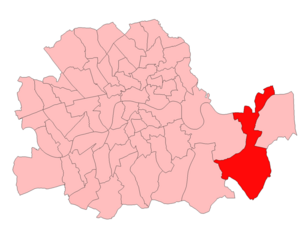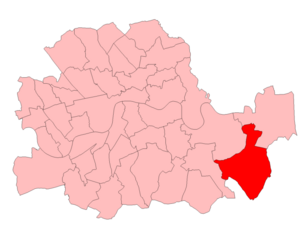Woolwich West (UK Parliament constituency) facts for kids
Quick facts for kids {{{Name}}}[[{{{Type}}} constituency]] |
|
|---|---|
| [[Image:{{{Map1}}}Constituency.svg|120px|]] [[Image:England{{{Map2}}}.svg|120px|]] |
|
| {{{Name}}} shown within [[{{{Entity}}}]], and {{{Entity}}} shown within England | |
| Created: | {{{Year}}} |
| MP: | {{{MP}}} |
| Party: | {{{Party}}} |
| Type: | House of Commons |
| County: | [[{{{County}}}]] |
| EP constituency: | [[{{{EP}}} (European Parliament constituency)|{{{EP}}}]] |
Woolwich West was an area in London that elected a person to represent it in the House of Commons. The House of Commons is part of the UK Parliament, where laws are made.
This area was called a 'constituency'. It existed from 1918 until 1983. Woolwich West was mostly around Eltham, which is now in the Royal Borough of Greenwich in south-east London.
The Woolwich West constituency was created for the 1918 general election. Before that, there was just one larger area called Woolwich. This was split into two new areas: Woolwich West and Woolwich East. When Woolwich West was stopped in 1983, its area mostly became the new Eltham constituency.
Contents
What Were the Boundaries of Woolwich West?
The boundaries of a constituency are like its borders. They show exactly which streets and neighborhoods are included. These boundaries can change over time.
Woolwich West Area: 1918–1950
From 1918 to 1950, Woolwich West included several 'wards' from the Metropolitan Borough of Woolwich. Wards are smaller local areas used for elections. These wards were Dockyard, Eltham, Herbert, River, St. George's, and St Mary's.
Woolwich West Area: 1950–1955
Between 1950 and 1955, the constituency's area changed slightly. It included the Avery Hill, Herbert, St George's, Sherard, and Well Hall wards of Woolwich.
Woolwich West Area: 1955–1974
From 1955 to 1974, the area grew to include more wards. These were Avery Hill, Coldharbour, Eltham Green, Falconwood, Herbert, Horn Park, Middle Park, New Eltham, St George's, Sherard, Shooters Hill, and Well Hall.
Woolwich West Area: 1974–1983
In its final years, from 1974 to 1983, the constituency was part of the London Borough of Greenwich. The wards included were Academy, Coldharbour, Eltham, Horn Park, Middle Park, New Eltham, St George's, Sherard, Shooters Hill, and Well Hall.
Who Represented Woolwich West?
The people who represent a constituency in Parliament are called Members of Parliament, or MPs. An MP is chosen by the people living in their constituency through an election. Here are the MPs who represented Woolwich West:
| Election | Member | Party | |
|---|---|---|---|
| 1918 | Sir Kingsley Wood | Conservative | |
| 1943 by-election | Francis Beech | Conservative | |
| 1945 | Henry Berry | Labour | |
| 1950 | William Steward | Conservative | |
| 1959 | Colin Turner | Conservative | |
| 1964 | Bill Hamling | Labour | |
| 1975 by-election | Peter Bottomley | Conservative | |
| 1983 | constituency abolished | ||
How Were MPs Chosen?
MPs for Woolwich West were chosen through general elections, which usually happen every few years. Sometimes, if an MP leaves their job before the next general election, a 'by-election' is held just for that constituency.
In these elections, people in Woolwich West voted for the candidate they wanted to represent them. The candidate who received the most votes won and became the MP. Over the years, both the Conservative Party and the Labour Party had MPs representing Woolwich West.
For example, in the 1979 general election, Peter Bottomley of the Conservative Party won with 21,222 votes. In the 1975 by-election, he also won, taking the seat from the Labour Party. Earlier, in 1964, William Hamling of the Labour Party won, gaining the seat from the Conservatives. These changes show how the political views of the people in Woolwich West shifted over time.




